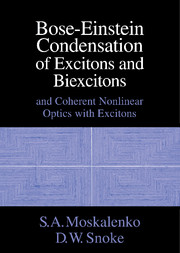Book contents
- Frontmatter
- Contents
- Preface
- 1 Introduction
- 2 Basic Theory of Bose–Einstein Condensation of Excitons
- 3 The Interaction of Condensed Excitons with Lattice Phonons
- 4 Bose–Einstein Condensation of Biexcitons
- 5 Phase Transitions and Thermodynamics of High-Density of Excitons
- 6 The Optical Stark Effect and the Virtual Bose Condensate
- 7 Bose–Einstein Condensation of Mixed States of Excitons and Photons
- 8 Nonequilibrium Kinetics of High-Density Excitons
- 9 Coherent Nonlinear Optics with Excitons
- 10 New Directions
- Appendix A: Properties of Excitons in Cu2O
- Author Index
- Subject Index
9 - Coherent Nonlinear Optics with Excitons
Published online by Cambridge University Press: 04 August 2010
- Frontmatter
- Contents
- Preface
- 1 Introduction
- 2 Basic Theory of Bose–Einstein Condensation of Excitons
- 3 The Interaction of Condensed Excitons with Lattice Phonons
- 4 Bose–Einstein Condensation of Biexcitons
- 5 Phase Transitions and Thermodynamics of High-Density of Excitons
- 6 The Optical Stark Effect and the Virtual Bose Condensate
- 7 Bose–Einstein Condensation of Mixed States of Excitons and Photons
- 8 Nonequilibrium Kinetics of High-Density Excitons
- 9 Coherent Nonlinear Optics with Excitons
- 10 New Directions
- Appendix A: Properties of Excitons in Cu2O
- Author Index
- Subject Index
Summary
Turbulence and chaos in a semiconductor crystal? These are just some of the intriguing predictions of nonlinear optics with coherent excitons. In this chapter we discuss some aspects of nonlinear coherent optics with the participation of the excitons, photons, and biexcitons. As in many nonlinear systems, these effects arise because of feedback mechanisms, i.e., the light impinging on the system affects the electronic states, which in turn affect the dielectric constant of the medium through which the light passes. These effects are closely related to the phenomena of self-organization [1-8] and optical bistability [7-10] and self-pulsations and the appearance of chaos [2-6]. The cooperative nonlinear coherent processes in optical systems have recently attracted much attention [7-20]. These investigations have stimulated the development of new mathematical methods [21-31] and have opened up possibilities for many new applications. The theoretical and the experimental investigations in these directions give rise to the theory of solitons [32∧2] and lead to the new developments in the optics of ultrashort pulses [43-58].
Ultrafast phenomena such as self-induced transparency and nutation are related to the propagation of solitons and pulse trains, whereas the transient stages of the ultrashort lightpulse penetration in the media are described by area theorems. These coherent ultrafast phenomena typically take place during intervals of time less than the relaxation time, i.e., femtoseconds to picoseconds in typical solids. Collisions and incoherent scattering processes destroy the coherent evolution of the excited particles. But if coherent macroscopic states of the excitons, photons, and biexcitons have been formed because of spontaneous or induced BEC, in this case one can consider their time evolution over intervals of time much greater than the relaxation time.
- Type
- Chapter
- Information
- Bose-Einstein Condensation of Excitons and BiexcitonsAnd Coherent Nonlinear Optics with Excitons, pp. 336 - 373Publisher: Cambridge University PressPrint publication year: 2000



